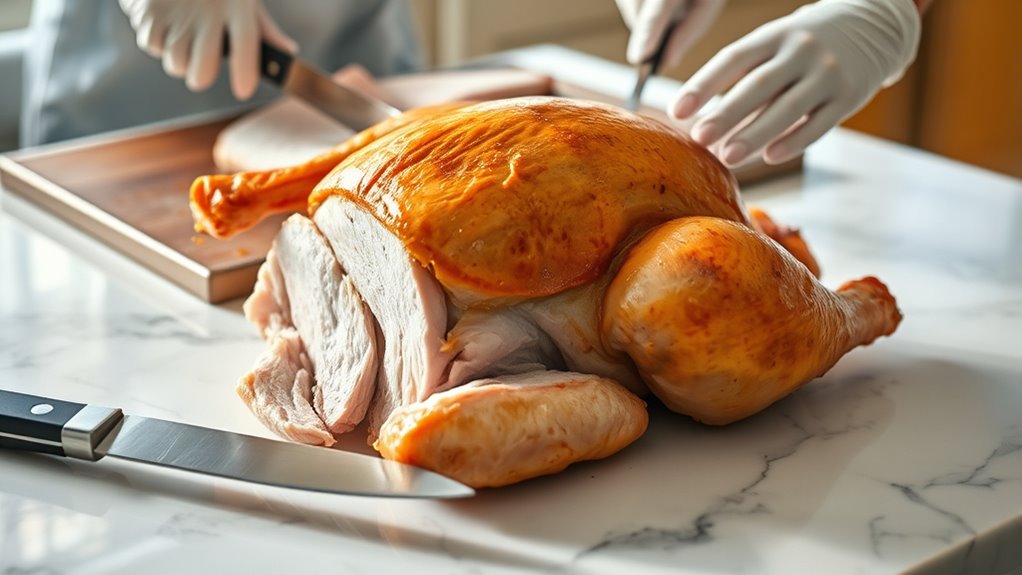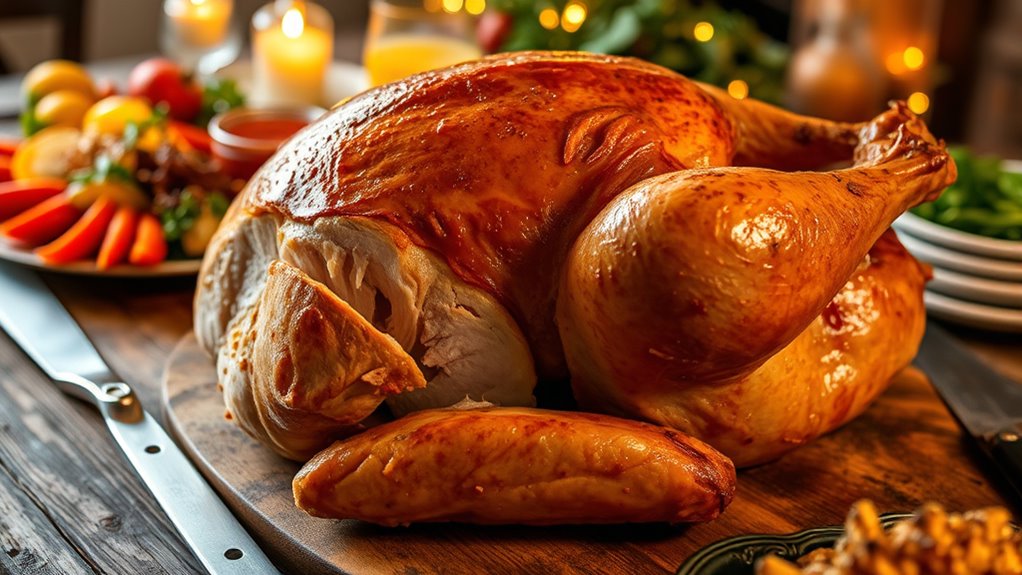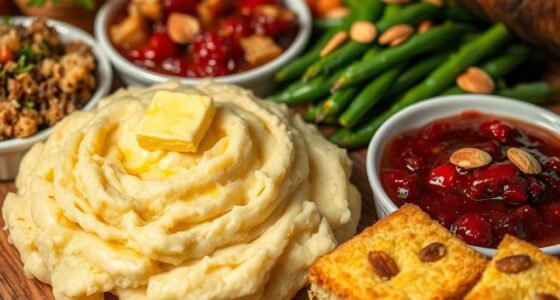To thaw your Thanksgiving turkey safely, plan ahead by refrigerating it for 24 hours per 4-5 pounds or use the cold water method, changing the water every 30 minutes. When carving, rest the turkey for 20-30 minutes, then use a sharp knife to carve against the grain. For serving, arrange neat, uniform slices on a platter, garnish with herbs or citrus, and add gravy or sauces. Keep learning for the perfect presentation and flavor.
Key Takeaways
- Thaw the turkey in the refrigerator or cold water, planning 24 hours per 4-5 pounds, and avoid room temperature thawing.
- Rest the turkey for 20-30 minutes after roasting to allow juices to redistribute for better tenderness.
- Carve against the grain with a sharp knife, removing legs and thighs first, then slicing the breast meat.
- Arrange slices neatly on a platter, garnished with herbs or citrus for visual appeal and enhanced presentation.
- Serve with gravy or sauces, and pour over slices just before serving to keep the meat moist and flavorful.

Are you unsure how to safely thaw, carve, and serve your Thanksgiving turkey? It might seem intimidating, but with a few simple steps, you can turn your turkey into a stunning centerpiece that not only tastes fantastic but also looks impressive. Proper thawing is key—plan ahead and give yourself enough time, ideally 24 hours for every four to five pounds of turkey. Thaw the bird in the refrigerator, keeping it at 40°F or below, and place it on a tray to catch any drips. If you’re short on time, you can use the cold water method: submerge the turkey in its original packaging in cold water, changing the water every 30 minutes until it’s fully thawed. Never thaw a turkey at room temperature, as this can promote bacteria growth.
Once thawed, it’s time to prepare for carving. Resting the turkey for 20 to 30 minutes after roasting helps the juices redistribute, resulting in tender meat and easier carving. When ready, use a sharp carving knife and a sturdy carving fork. Start by removing the legs and thighs, then carve the breast meat against the grain for maximum tenderness. Take your time—careful, confident slicing will produce cleaner, more attractive pieces. The way you carve directly impacts your plating presentation; neat slices make the dish look professional and inviting. Pay attention to how the slices are arranged on the platter, creating a visually appealing display that complements your table setting. A well-presented turkey not only enhances the overall dining experience but also elevates the turkey flavor enhancement, as the visual appeal can increase anticipation and enjoyment.
When serving, consider the presentation on the platter. Arrange the slices artfully, with some garnish like fresh herbs or citrus slices for color contrast. This adds vibrancy and makes your turkey the star of the table. If you’ve seasoned or marinated the turkey beforehand, carving allows those flavors to shine through in each slice, adding to the overall taste experience. For added flavor, serve with complementary sauces or gravy on the side, which can be poured over the slices just before serving to keep the meat moist and flavorful.
Frequently Asked Questions
How Long Should I Let the Turkey Rest Before Carving?
You should let your turkey rest for about 20 to 30 minutes before carving. This resting time allows the juices to redistribute, ensuring moist, flavorful meat. Use carving tips like tenting the turkey loosely with foil to keep it warm during this period. Don’t skip resting; it makes a big difference in how your turkey looks and tastes, giving you a perfect presentation and easier carving.
What Are Safe Methods to Reheat Leftover Turkey?
To safely reheat turkey leftovers, you should use safe reheating methods like microwave, oven, or stovetop. Guarantee the turkey reaches an internal temperature of 165°F to kill bacteria. Cover leftovers to retain moisture and heat evenly. Avoid reheating multiple times, as it can compromise safety. Always check the temperature with a meat thermometer before serving, and consume leftovers within 3-4 days for maximum safety.
Can I Cook a Frozen Turkey Without Thawing?
Imagine a frozen turkey, as solid as a winter lake, waiting to be transformed. Yes, you can cook a frozen turkey without thawing, but it takes longer and requires careful attention to cooking safety. You’ll need to increase the cooking time by about 50%, make certain a meat thermometer registers 165°F in the thickest parts, and avoid stuffing until fully cooked. This way, you safely enjoy your holiday feast.
How Do I Prevent the Turkey From Drying Out During Carving?
To prevent your turkey from drying out during carving, focus on proper brining techniques and basting strategies. Brining keeps the meat moist and flavorful, so consider a wet or dry brine before cooking. During roasting, baste the turkey periodically with pan juices or broth to maintain moisture. Also, let the turkey rest for at least 20 minutes after cooking; this helps the juices redistribute, ensuring a juicy, tender carve.
What Are Alternative Ways to Serve Turkey Besides Traditional Carving?
Who needs traditional carving when you’ve got clever alternatives? You can make turkey roll-ups, layering slices with cheese and herbs for a fancy twist. Or, shred the turkey and create delicious shredded turkey sandwiches, perfect for a quick, casual meal. These options keep things fun and stress-free, plus they let you enjoy the turkey’s flavor without the fuss of slicing. Sometimes, breaking from tradition is the best part of the feast!
Conclusion
As you carve into that perfectly thawed, golden-brown turkey, imagine the warmth and joy filling your home. The aroma dances in the air, bringing everyone closer together. With each slice, you create more than just a meal—you craft memories. Serve it with pride, knowing you’ve guided it from freezer to feast with care. This moment, shared around the table, becomes a treasured part of your Thanksgiving story.









